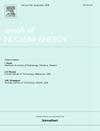单相水交叉流作用下管束流体弹性失稳的实验研究
IF 1.9
3区 工程技术
Q1 NUCLEAR SCIENCE & TECHNOLOGY
引用次数: 0
摘要
核电站蒸汽发生器的大部分故障都是由壳体侧的横向流动引起的流激振动引起的。了解管束的FIV特性对管束布置设计和设备安全验证等工程问题具有重要意义。本文详细研究了正交三角形、平行三角形和旋转不规则三角形三种阵列在交叉流中的FIV特性。分析了阵列结构、螺距比和环管刚度对FIV的影响。根据实验数据对理论模型进行了修正。实验过程中,降低速度(Vp)逐级增加,直至破坏管束,导致实验终止。Vp的取值范围是0-3.5。本文分析了湍流激励、涡流脱落和流体弹性失稳(FEI)三个阶段的频域和时域特性。结果表明:在1.6 ~ 2.5范围内,随着螺距比的增大,允许进口流速增大,管束更加稳定;在较小的节距比下(小于1.6),FEI更容易发生在中央管。当螺距比较大(大于2.5)时,在中心管和下游管中同时发生FEI。结果还表明,横向FEI的Vpcr与螺距比之间存在较弱的相关性。流向FEI的Vpcr与基音比有很强的相关性。管间耦合对流向非均匀流的发生有重要影响。在管周围布置刚性管比布置柔性管更稳定。在实验数据的基础上,新的理论模型考虑了旋转不规则三角形结构的Vpcr随节距比的具体变化。不稳定常数为2.54,指数常数为0.5。本文章由计算机程序翻译,如有差异,请以英文原文为准。
Experimental research on fluid elastic instability in tube bundles subjected to single-phase water cross-flow
The majority of failures in steam generators in the nuclear power plant can be attributed to flow-induced vibrations (FIV) resulting from the cross-flow on the shell side. Understanding the FIV characteristics of the tube bundle plays a significant key in engineering issues, such as the design of tube bundle arrangements and safety verification of equipment. This paper conducts a detailed investigation into the FIV characteristics of three types of arrays with normal triangular, parallel triangular, and rotated non-regular triangle in the cross flow. The effects of the array configuration, pitch ratio, and stiffness of surrounding tubes on FIV were analyzed. The theoretical model was modified based on the experimental data. The reduced velocity (Vp) was increased in a stepped manner during the experiment until the tube bundle was damaged, which led to the termination of the experiment. The range of Vp is 0–3.5. This study analyzed the frequency-domain and time-domain characteristics of three stages: turbulence excitation, vortex shedding, and fluid-elastic instability (FEI). The results indicate that within the range of 1.6 to 2.5, as the pitch ratio increases, the allowable inlet flow velocity becomes larger, and the tube bundle becomes more stable. Under small pitch ratios (less than 1.6), FEI is more likely to occur in the central tube. When the pitch ratio is larger (greater than 2.5), the FEI occurs simultaneously in the central tube and the downstream tube. It is also shown that there is a weak correlation between the Vpcr of transverse FEI and the pitch ratio. There is a strong correlation between the Vpcr of streamwise FEI and the pitch ratio. The coupling between tubes has a significant impact on the occurrence of streamwise FEI. Arranging rigid tubes around the tube is more stable than arranging flexible tubes. Based on the experimental data, the new theoretical model considers the specific variation of the Vpcr with the pitch ratio for rotating non-regular triangular structures. The instability constant is 2.54, and the exponent constant is 0.5.
求助全文
通过发布文献求助,成功后即可免费获取论文全文。
去求助
来源期刊

Annals of Nuclear Energy
工程技术-核科学技术
CiteScore
4.30
自引率
21.10%
发文量
632
审稿时长
7.3 months
期刊介绍:
Annals of Nuclear Energy provides an international medium for the communication of original research, ideas and developments in all areas of the field of nuclear energy science and technology. Its scope embraces nuclear fuel reserves, fuel cycles and cost, materials, processing, system and component technology (fission only), design and optimization, direct conversion of nuclear energy sources, environmental control, reactor physics, heat transfer and fluid dynamics, structural analysis, fuel management, future developments, nuclear fuel and safety, nuclear aerosol, neutron physics, computer technology (both software and hardware), risk assessment, radioactive waste disposal and reactor thermal hydraulics. Papers submitted to Annals need to demonstrate a clear link to nuclear power generation/nuclear engineering. Papers which deal with pure nuclear physics, pure health physics, imaging, or attenuation and shielding properties of concretes and various geological materials are not within the scope of the journal. Also, papers that deal with policy or economics are not within the scope of the journal.
 求助内容:
求助内容: 应助结果提醒方式:
应助结果提醒方式:


